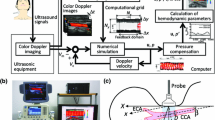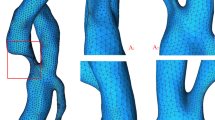Abstract
Doppler ultrasound is a usual non-invasive method to estimate the stenosis percentage in large arteries such as carotid by measuring maximum velocity of blood flow. Based on clinical investigations, because of vessel wall motions, Doppler positioning and angle correction, some errors can arise in Doppler results which lead to incorrect diagnosis. The aim of this study was to compare the results of Doppler test and the numerical simulation of blood flow in the same case. For this evaluation, two patients including an 87-year-old man and a 72-year-old woman suffering from stenosis in the internal carotid artery were selected. First, clinical information of each patient such as CT-Angio scan images and Doppler ultrasound results on different locations of the stenosed artery were obtained. Then, the geometries were reconstructed and numerical simulations were carried out using ANSYS software. Results showed that the velocity profile of Doppler test and numerical simulation were in good agreement at the regions of pre-and post-stenosis. However, the value of maximum velocity at the stenotic region had significant differences.










Similar content being viewed by others
References
Timsit SG, Sacco RL, Mohr JP et al (1992) Early clinical differentiation of cerebral infarction from severe atherosclerotic stenosis and cardioembolism. Stroke 23:486–491
Grant EG, Benson CB, Moneta GL et al (2003) Carotid artery stenosis: gray-scale and Doppler U.S. diagnosis—Society of Radiologists in Ultrasound Consensus Conference. Radiology 229:340–346
Scoutt L, Grant E (2009) ARRS Categorical course.
Samuel L, Bridgers MD (1989) Clinical correlates of Doppler/ultrasound errors in the detection of internal carotid artery occlusion. Stroke 20:612–615
Fell G, Phillips DJ, Chikos PM, Harley JD, Thiele BL, Strandness DE (1981) Ultrasonic duplex scanning for disease of the carotid artery. Circulation 64:1191–1195
Zweibel WJ, Crummy AB (1981) Sources of error in Doppler diagnosis of carotid occlusive disease. Am J Neuroradiol 2:231–242
Shahcheraghi N, Dwyer HA, Cheer AY, Barakat AI, Rutaganira T (2002) Unsteady and three-dimensional simulation of blood flow in the human aortic arch. J Biomech Eng 124:378–387
Xu XY, Collins MW (1995) Numerical modelling of blood flow in compliant arteries and arterial bifurcations. Fluid mechanics. Computational Mechanics Publications, Boston, pp 55–93
Zhao SZ, Xu XY, Hughes AD et al (2000) Blood flow and vessel mechanics in a physiologically realistic model of a human carotid arterial bifurcation. J Biomech 33:975–984
Perktold K, Rappitsch G (1995) Computer-simulation of local bloodflow and vessel mechanics in a compliant carotid-artery bifurcation model. J Biomech 28:845–856
Bathe M, Kamm RD (1999) A fluid–structure interaction finite element analysis of pulsatile blood flow through a compliant stenotic artery. J Biomech Eng 121:361–369
Tang DL, Yang C (2001) 3D steady and unsteady blood flow in stenotic collapsible arteries with symmetric and asymmetric stenoses. Recent advance s in biomechanics. China Higher Education Press/Springer, Beijing/Berlin, pp 171–191
Hughes TJR, Liu WK, Zimmermann TK (1981) Lagrangian–Eulerian finite element formulation for incompressible viscous flows. Comp Meth Appl Mech Eng 29:329–349
Tang D, Yang C, Kobayashi S, Ku DN (2001) Generalizes finite deference method for 3-D viscous flow in stenotic tubes with large wall deformation and collapse. J Appl Num Math 38:49–68
Lee KW, XU XY (2002) Modeling of flow and wall behavior in a mildly stenosed tube. Medical Eng Phy 24:575–586
Li Zh, Kleinstreuer C (2007) A comparison between different asymmetric abdominal aortic aneurysm morphologies employing computational fluid-structure interaction analysis. Eur J Mech B 26:615–631
Khanafer K, Bull JL, Berguer R (2009) Fluid-structure interaction of turbulent pulsatile flow within a flexible wall axisymmetric aortic aneurysm model. Eur J Mech B 28:88–102
Tang D, Yang C, Walker H, Kobayashi S, Ku D (2002) Simulating cyclic artery compression using a 3D unsteady model with fluid–structure interactions. Comput Struct 80:1651–1665
Johnston BM, Johnston PR, Corney S, Kilpatrick D (2004) Non-Newtonian blood flow in human right coronary arteries: steady state simulations. J Biomech 37:709–720
McDonald DA (1974) Blood flow in arteries. Camelot Press, UK
Ghalichi F, Deng X, De Champlain A et al (1998) Low Reynolds number turbulence modeling of blood flow in arterial stenoses. Biorheology 35:281–294
Robertson AM, Sequeira A, Kameneva M (2008) Hemorheology. In: Galdi GP, Rannacher R, Robertson A (eds) Haemodynamical flows: modelling analysis and simulation, Oberwolfach Seminars, Birkhauser 37: 63–120
Robertson AM, Sequeira A, Owens RG (2009) Rheological models for blood. In: Quarteroni A, Formaggia L, Veneziani A (eds) Cardiovascular mathematics. Modeling and simulation of the cardiovascular system. MS & A, vol 1.
Gijsen FJH, Van de Vosse F, Janssen JD (1999) The influence of the non-Newtonian properties of blood on the flow in large arteries: steady flow in a carotid bifurcation model. J Biomech 32:601–608
Wilcox DC (1994) Simulation of transition with a two-equation turbulence model. J AIAA 32:247–255
Kensey KR, Cho YI, Chang M (1997) Effects of whole blood viscosity on atherogenesis. J Invasive Cardiol 9:17–24
Kamenskiy A, et al (2011) Comparative analysis of the biaxial mechanical behavior of carotid wall tissue and biological and synthetic materials used for carotid patch angioplasty. J Biomech Eng 133:111008–111010
Author information
Authors and Affiliations
Corresponding author
Rights and permissions
About this article
Cite this article
Hassani-Ardekani, H., Ghalichi, F., Niroomand-Oscuii, H. et al. Comparison of blood flow velocity through the internal carotid artery based on Doppler ultrasound and numerical simulation. Australas Phys Eng Sci Med 35, 413–422 (2012). https://doi.org/10.1007/s13246-012-0162-0
Received:
Accepted:
Published:
Issue Date:
DOI: https://doi.org/10.1007/s13246-012-0162-0




